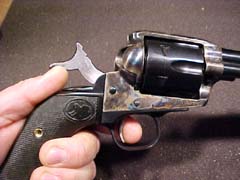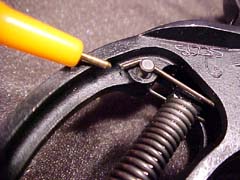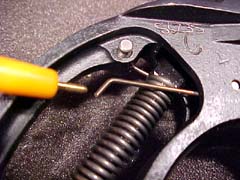|
Many, if not most, revolvers leave the factory these days with what can
charitably be called a less than satisfactory trigger pull. The
typical factory trigger consists of a gritty feeling pull with excessive weight. Trying
to shoot a three pound sixgun with a seven pound trigger pull is not conducive
to accurate shooting. Add to that a rough feeling sear engagement, and hitting the
target becomes more luck than skill.
It is however, easy to understand why any gun manufacturer would want a trigger that
could in no way be released by accident.
However, a rough, gritty trigger is never
acceptable. The usual solution is to send the gun to a competent gunsmith, along
with a good sum of cash, and in a few weeks you will have a sixgun with a
trigger pull that is as smooth as silk and as crisp as that new C-note that you gave
to the gunsmith.
While the money spent on such a good
trigger job is well worth the cost. There are many shooters, myself included, who
would rather dispense with the added cost and time delay, and just get to enjoy the
new revolver. For those, there is a much simpler and cheaper solution. It's what I
call a "Poor Boy's Trigger Job", hence the title of this article.
This type of trigger work can be performed on most revolvers, with slight
variations. I have done such to many Smith & Wesson, Taurus, Colt, and
Ruger double actions, but due to their popularity, this article will deal with the
single action Ruger, specifically the New Model Blackhawk and Vaquero.
The first operation deals with smoothing the mating surfaces of the sear and
trigger. What we are trying to do here is what is called "marrying the trigger". It is
very simple. After making sure that the gun is unloaded, look and make sure that
it is unloaded again. Next, while applying upward pressure with your thumb to the
cocked hammer, pull the trigger. You need to apply a good deal of pressure with that
thumb. Repeat this step a few times until the trigger pull feels smooth and the gritty
feel of the new trigger pull is gone. This removes the microscopic burrs from the
surfaces, resulting in a smooth release. Don't over-do it. You want to smooth it, not
wear it out.
The next step requires that you remove either of the grip panels, and lift one leg of
the trigger return spring from its post, allowing it to hang free. This effectively
reduces the spring tension of the trigger, resulting in a reduced weight of pull.
I have, on occasion, also clipped a couple of coils from the hammer spring, but it is
usually not necessary, and could result in misfires. The first two steps will most likely
result in an excellent trigger pull.
I do not suggest that you try this procedure on a
lower quality revolver. If the gun has good, hard internal parts, this procedure will do
no harm, and results in a surprisingly good trigger pull, for
absolutely no money. On a cheap gun with soft parts, you will ruin the trigger, but if
you were the kind of person who bought junk guns, you probably wouldn't be
reading Gunblast to begin with.
There it is; the "Poor Boy's Trigger Job". I did not invent the procedure, but have
successfully used it on many sixguns with great results. It takes longer to read this
than to perform the operation on your gun. Before spending several dollars to slick
up the action of your newest sixgun, give it a try. I think that you will be pleased.
Jeff Quinn
  
Got something to say about this article? Want to agree (or
disagree) with it? Click the following link to go to the GUNBlast Feedback Page.
All content © 2001 GunBlast.com.
All rights reserved. |
|
The following pictures
illustrate the author's procedure for smoothing &
lightening the trigger pull on a sixgun. A Ruger Vaquero is
shown for illustration, but the procedure is similar for many
quality revolvers.
  


The above pictures show the procedure for
"marrying" the trigger as described by the author.
This simple procedure smoothes the sear & trigger a great
deal without even having to disassemble the gun!

With either grip panel removed, the trigger return
spring will be visible. On Ruger SA revolvers, the trigger
return spring will bear against a pin at the top of the
mainspring at either side as shown.

Simply lift one side of the trigger return spring from
the pin, and you have dramatically reduced the trigger pull
without affecting the weight of hammer fall or detracting from
the function of the revolver. Author has used this procedure
too many times to count, and it results in a smoother,
lighter, reliable trigger at no cost!
|
![]()